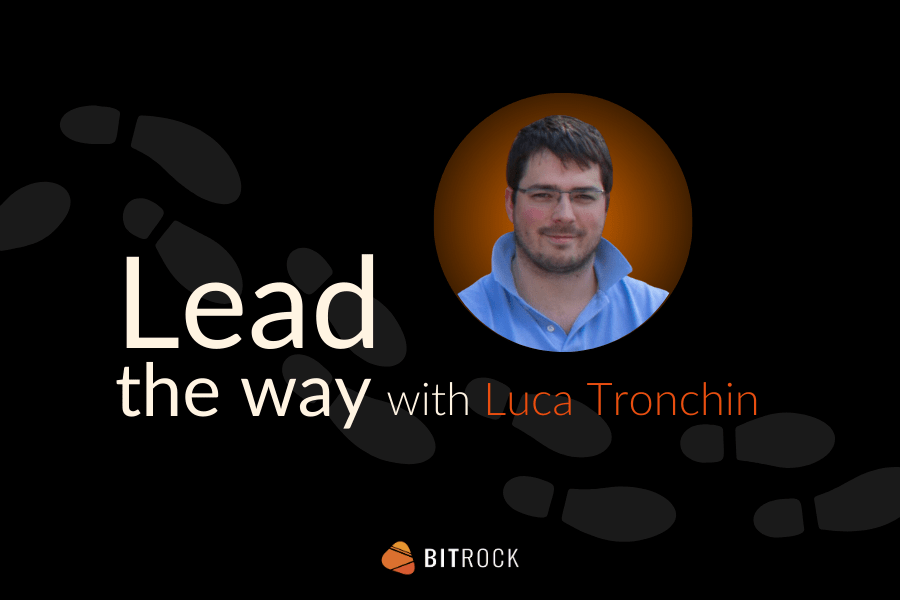Today we will learn more about the role of Team Lead thanks to this new interview with Luca Tronchin, who has been working at Bitrock since 2015. Luca has grown a lot in all these years, and is now able to play this important role with success and great satisfaction! Let’s now get to know him better.
Can you explain your journey so far, from Developer to Team Leader, and the skills that have been most useful to you?
My journey essentially began at university, where I developed a strong interest in distributed and complex systems, and learned how to manage and evolve them through the use of well-designed architectures and structured models.
So I started my career as a Software Engineer working with Scala, whose rigid type system and formalism prevail over the too-easy starting points of other programming languages, where bad practices are tolerated and have to be dealt with later.
I was lucky enough to dabble in web and mobile development early in my career, before concentrating on back-end development, where I learned about a variety of software architectures – mostly microservices – and a wide range of related issues.
In later years, I’ve been involved in a project where I’ve helped evolve the architectures, both enjoying the good decisions and suffering the bad ones, but it’s mostly the latter that has added to my experience.
Can you describe a typical working day for you?
I often start my day with two or three standup meetings, depending on the number of teams or projects I am working on, to address any urgent team needs. In this scenario, the main priority is to resolve the issues and clear the way for the necessary people to participate in the activities. If there isn’t an immediate need, the objective shifts to making sure that the team members have enough work to do during the next sprints.
Because Bitrock uses an agile approach, the project’s high-level roadmap is set up in advance, but the day-to-day tasks are defined a few weeks in advance, allowing for the development and consolidation of prerequisites. As a result, the team works more efficiently.
The afternoon is usually dedicated to architectural, technical and non-functional meetings aimed at improving the overall project. The day usually ends with some low-priority activities that are usually left aside, but give us the opportunity to reflect on them in a quiet way.
What does being a bitrock team leader mean to you?
At Bitrock, a Team Leader is someone who can manage a variety of situations, such as organizing an ongoing project or developing one that is about to start, discussing and defining possible solutions with the client, and dealing with any organizational issues that may arise within the team. It is necessary to have the soft skills to deal with often unpleasant situations and challenging discussions – where the aim is to reach an agreement between both sides that will help people to progress in their work. Knowledge of architecture and team organisation is also required. Fortunately, this does not happen often, but when it does, it needs to be handled correctly.
What do you find most rewarding about your role?
The most fulfilling part of being a team leader at Bitrock is being able to help your teammates succeed in their endeavours.
When I first started working as a developer, I believed that most of the effort required to create a successful product was in the actual coding and writing of the software. These days, however, most of my time is spent in meetings aimed at streamlining processes and fostering teamwork.
What was the most challenging situation you faced?
In this role, mediating disputes between parties with widely differing views is always the most difficult situation I face. In some situations you are the one who has to make the final decision, and in those situations it is your responsibility to give the best possible reasons for the decision; in other situations you have to try to make the decision by explaining the various aspects of the recommended course of action.
How do you balance technical and managerial aspects?
There is not much to balance except the most scarce resource: time.
Being a Team Leader, as I said above, means being involved in a lot of issues, and all of them would require dedicated care and attention. So it’s really important to be organized, to be able to devote the right amount of time to each topic, because things can rarely be ignored, and things can’t always be managed in an emergency situation.
Luckily, a great help comes from colleagues who understand that you are there to help make the work run more smoothly, and they trust you to let them help.
What is your favorite memory so far?
It’s hard to pick the ‘best’, but my team and I were able to complete a very long and difficult project last year. The main challenge was that there were several teams involved in different parts of the system; our team consisted of only about 15 members. There were many details to coordinate and modify, and the other teams came from different consulting firms in Italy, France and the US. It’s incredible to see how quickly and efficiently such a complex project was completed.
Thanks to Luca Tronchin, Team Lead Engineering @ Bitrock, for this interview.
Ready for the next episode of our journey to meet our Team Leaders?

